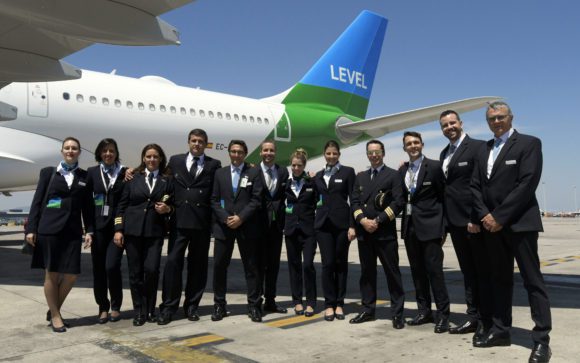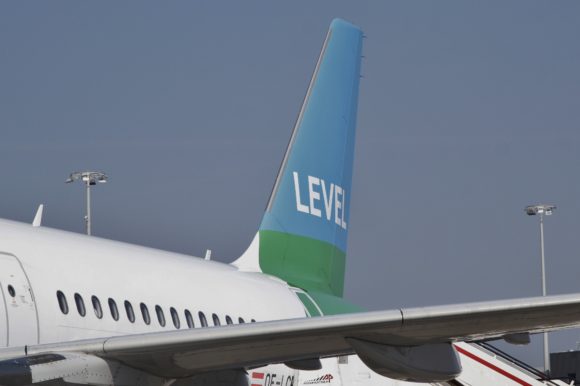International Airlines Group (IAG) latest offspring LEVEL has further spread its wings by opening a new short-haul base at Amsterdam Schiphol Airport on April 6. Maybe seen a bit as an enigma to some, the launch presentation press conference was a nice opportunity for Airinsight to catch up with LEVEL’s CEO Vincent Hodder.
But wait a minute: opening a new short-haul base… Isn’t LEVEL the long-haul low-cost carrier of IAG, among its bigger sisters British Airways, Aer Lingus, Iberia and Vueling? Indeed, and that’s how it began on June 1, 2017, when LEVEL started operations out of Barcelona to Los Angeles, soon followed by San Francisco, Punta Cana, and Buenos Aires, using Iberia staff and three Airbus A330-200s repainted in the airline’s white/green/blue livery.
A year later, on July 1, 2018, LEVEL France at Paris Orly became operational on the foundations of IAG’s Open Skies, using two A330s to New York Newark, Montreal and to the more traditional French Caribbean destinations Martinique and Guadeloupe. On board, it offers Economy and Premium seats with payed-for meals and drinks, Wifi (on long-haul) and until July free entertainment.
A little over two weeks later on July 17, LEVEL started its first short-haul operations out of Austria’s capital Vienna, using a dedicated vehicle called Anisec Luftfahrt. Its four A321s fly to fourteen destinations, including London, Paris, Barcelona, Ibiza, Milan, Dubrovnik and since last week Hamburg. Anisec was formed in just 3,5 months, after in late 2017 IAG’s Vueling bid on Fly Niki had failed, as first LaudaMotion and later Ryanair became the new owner. With Ryanair, Wizz Air, easyjet and of course Austrian Airlines in there, the Vienna market had become too important for IAG to neglect.
Amsterdam strategic opportunity
Now on April 6, 2019, after preparations since late last Summer, LEVEL opened its second short-haul base at Schiphol. “It is a strategic opportunity we wanted to take advantage of”, says Vincent Hodder. “Within IAG, Vueling had a base in Amsterdam but never had crew here. The crew was based out of Barcelona, the aircraft were in Amsterdam. That created inefficiencies and operating out of Amsterdam was never popular with the crew.”
In a move that is controversial with Spanish trade unions, IAG decided to swap precious Vueling slots at Schiphol for LEVEL to fly on non-Spanish routes, while at the same time recruiting staff locally as well as within Anisec’s Austrian pool. “Eventually, we will base here 30 cockpit crew and 60 cabin crew, most of them Dutch. Actually, the first group will complete their training on April 18”, says Hodder. There have been discussions with both Austrian and Spanish working councils, but “they have a clear understanding of what LEVEL stands for”.
A special welcome for the LEVEL A321 at Schiphol on April 7. The actual first service from Amsterdam was the day before. (LEVEL)
At first it was thought LEVEL would operate three A320s at Schiphol, but actually, they are A321s. The first has started commuting daily between London Luton, Vienna and Rome, while a second will arrive mid-June to double frequencies. From June 21/22 LEVEL was to start services to Lissabon and Milan Malpensa. It has also been seen doing flights to Pharos (Greece) with an A320. A third A321 would join Amsterdam by mid-August, allowing for flights to Fuerteventura. Hodder will consolidate for the Winter season but is looking for options for 2020.
If LEVEL wishes to expand at Schiphol, it can only be done by swapping additional slots with IAG-owned airlines, admits Hodder, as under much public and political debate Schiphol has reached its limit of 500.000 movements a year.
The A321s based in Amsterdam have a 210-seat configuration, so below the average 235 used on the type: “We have taken into consideration that Dutch customers are taller, so we offer them 31-inch seat pitch”, Hodder explains. With a five-percent seat cost advantage of the A321, this reduced capacity version is still making money.
Born out of a white spot
The LEVEL-concept was born out of something that was missing within IAG, says Hodder: “Where IAG had a white spot was around the long-haul, value-seeking, modern-minded consumer. The brands of the Group really didn’t meet this, so LEVEL was specifically created to target that group”. IAG wished to do something different too: build an airline that was less vertically structured around the production-side, but around the customer/airline relationship. Hodder calls it ‘the airline of the future”.
Having initially been run by IAG’s director of strategy Robert Boyle, last September Vincent Hodder joined LEVEL as its first CEO, bringing with him experience from flybe, VivaAerobus, JetStar Japan and TACA in El Salvador. “What’s very special about LEVEL is that it’s an airline that has been created from the ground up to take advantage of every evolution that we have in terms of airline business models. For me, it’s the first time that a number of components have been put together in a new configuration. For example, I worked at TACA which used multiple AOC’s under a single brand: that’s what we do at LEVEL. I used to work at flybe: they provided third-party capacity to SAS. We do that too. I was part of Jetstar, the first successful low-cost airline as part of a full-service airline group. We were the first successful example of low-cost long-haul and we are taken the lessons out of that process as well.”
CEO Vincent Hodder is with LEVEL since September 2018. (Richard Schuurman)
“What we are doing at LEVEL is in the creation of the future airline, taking elements that have been proven with other airlines at other parts of the world and putting those together in a new configuration which has never existed before. This way of separating the production from the commercial operations and from making the customer truly central to the structure of the airline makes it a huge difference. (…) Our business model gives us the flexibility that traditional airlines just don’t have. By setting up separate operations focused on different types of flying, what we are able to do is make sure that each of those operations serves the specific needs of its markets, its routes, and its customers.”
Does this make LEVEL a guinea pig within IAG? Hodder: “Perhaps not a guinea pig, but perhaps call it a testbed. Yes, the Group looks at LEVEL because it is smaller, more nimble and flexible. We can trial things at LEVEL that if they work, we can take that concept back to the Group and if they don’t work we are small enough to change those very quickly. If you want to do these sorts of experiments, you can’t just take people out of your existing structure and do it. What IAG has done is that it has brought me in because of the particular experience that I have. I brought in a team of people who have all come with parts of that experience with me, so we are bringing different capabilities to the Group.”
Where are the numbers?
Almost two years since the start, how is LEVEL fairing? Within IAG’s annual reports you will look for its financial statistics in vain, as the airline group is not willing to disclose them. Last year’s report only says LEVEL flew 888.000 passengers on 25 destinations with nine aircraft, but that’s it. Since January, IAG’s monthly traffic updates include LEVEL, showing triple digit numbers year-on-year (March passengers +347.8 percent to 103.000).
Group CEO Willie Walsh confirmed that Barcelona operations are doing ‘exceptionally well’ and so says Hodder: “It significantly has exceeded expectations. Spanish customers appreciate the service level traditionally offered by legacy carriers with our low-cost price composition.”
Paris operations have become more efficient compared to the days they were run as Open Skies, but LEVEL is said to be loss-making at Paris Orly. Hodder isn’t willing to confirm this, only saying: “It’s a transition from a full-service into a low-cost operation, but it does take some time to get back to the core model of what low-cost/long-haul actually looks like in Barcelona.” The market also has a very different structure, with dense routes for markets popular with the French.
In Vienna, “customers love the product and we have a high promoter score of high 60s on a scale up to 100, which is really high and puts us up with the best scoring airlines in the world. But Vienna is also a very competitive market”.
Lean operations, low costs
From the day it started operations in Barcelona Iberia staff volunteered to join the new airline, despite working more hours for remuneration that according to Hodder is at the bottom end of the market. Yet, staff like it so much at LEVEL that quite a few have requested an extension to their one-year contracts. “That voluntary nature has made them more pro-active, more customer-focused and more engaged than what I have seen at traditional airlines”, says Hodder. Staff willing to go the extra mile benefits productivity and is one factor in having lower costs per capita.
LEVEL operates from Barcelona with Iberia crews, many of whom have joined on a voluntary basis. (LEVEL)
What helps too is having a very lean structure. Just this week Hodder employed his second member of staff. All other services are sourced from within IAG, taking out a lot of costs from operating the airline. “As we roll out technology that supports our crew and operations and as we take away the need for people to do the physical work, we free them up to engage actively with customers. And that is very much part of what the airline of the future is about”. A lean structure shows. While Hodder doesn’t have exact numbers available of his Spanish/Iberia operation, Paris has only 250 and the combined Anisec operations in Vienna/Amsterdam have 170.
The financial backing from IAG has allowed LEVEL to start-up, especially when developing the long-haul routes “as the maturity of long-haul is significantly longer than that of short-haul routes.” But long-haul will ”absolutely” be profitable, says Hodder. IAG’s resources are also much-needed to establish the Vienna base.
Expanding and connecting the network
LEVEL will expand its long-haul activities this year. It dropped Los Angeles after only a year as well as Punta Cana, but added Boston and since April 1 Santiago de Chile too from Barcelona. “We could not keep LA as well as doing Santiago at the same time, while San Francisco did perform better than LA. But I never rule anything out and go back to Los Angeles”. It will add New York JFK from July after taking delivery of a brand-new A330-200 ordered at last year’s Farnborough Air Show, bringing the Barcelona-fleet to four A330s. Paris will get the other new A330 in October, adding to the two already based at Orly.
More routes to South America are planned, while longer term the airline is looking at Asia. “It is certainly in our consideration set. We are very interested in Asia. The sort of product that LEVEL delivers will play very, very well in Asian markets, so it is absolutely something we are looking at for the future”.
Although limited in size, LEVEL is connecting its short and long-haul services to create a proper network. “From the way we have established four bases in two years, you can see we are clearly a pan-European business. It is not just about one particular country or city, it is about providing our services to the broadest set of customers. At the same time, we are not a hub carrier. We will not be putting up routes in a short-haul part of the business that would have to be cross-subsidized by long-haul operations. Each route has to stand on its own and where we can get connectivity we will take advantage of that”.
Connecting short-haul and long-haul is done in Barcelona and Paris, but with the help of Vueling this model will evolve to offer more connectivity between different basis. Amsterdam will most likely become another base for long-haul routes. “We have a desire to do long-haul from Amsterdam, but we have chosen to launch Amsterdam as a short-haul”, admits Hodder.
LEVEL is using five Airbus A330-200s on its long-haul operations and will take delivery of two brand-new ones in July and October. (LEVEL)
Competition over fleet plans
The CEO hopes to get approval for his fleet-plan for 2020-2021, looking at both growth and replacement. While the A330-200s are all quite new (the oldest is just over two years), the type will cease production mid-next year. LEVEL is having a look at both the A330neo and Boeing 787, both considered as a new platform to the airline that puts them on par for the shoot-out. The short-haul fleet is much older (the oldest is over 16 years, the youngest some four years), with many former Niki-aircraft. They didn’t need much refurbishment before entering service with LEVEL and are cheap to run (as long as fuel prices don’t increase), but age will be showing.
Getting board-approval is not that easy: “Within IAG, we are in constant competition for capital. We have to justify each year what our growth is going to be, but I expect a decision will evolve over the course of the next six months.” Hodder doesn’t feel his growth is being restrained by the demands put on him by the board: “The group provides discipline to us so that we don’t over-invest in the fleet.”
Whatever type is chosen, Hodder is wary of too many types within his fleet: “What is really critical is that we maintain the cost-base really low. We need to avoid the complexity of having multiple types of aircraft or even variant within a type that increase our level of complexity. As we bring in a new type, we don’t want to bring that in right across the portfolio but isolate that type to a particular AOC and then move other aircraft so that we can consolidate the same type within each operation”.
Looking ahead, Vincent Hodder is optimistic about the future of LEVEL. Where will the airline be in a year from now? “The only thing I can say is that it will be bigger than it is today! We have to continue to deliver the results that we are delivering and improve everything we do. I think we have the lowest costs of any long-haul airline, certainly in Europe. That will stand us in really go state for future growth”.
LEVEL logo on A321 tail. (Richard Schuurman)
Views: 1








